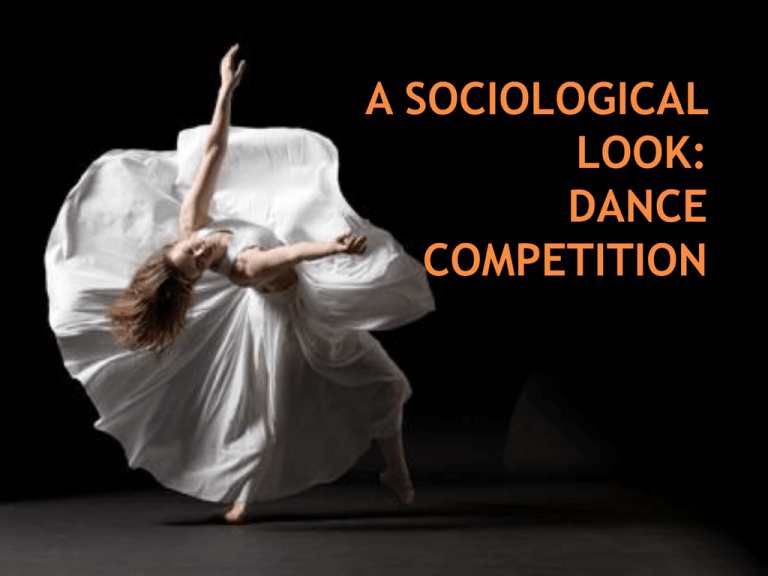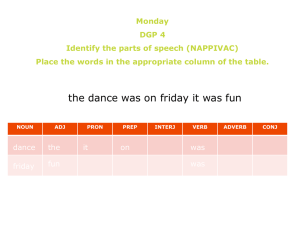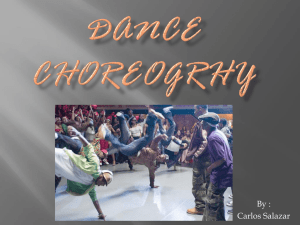A Sociological Look: Dance Competition
advertisement

Competitive dance is a widespread activity that requires dancers to perform dances in any of the several permitted dance styles. Acrobats Ballet Jazz Hip-Hop Lyrical Modern Tap Judges, who are usually former professional dancers or instructors, score each performance in many categories. Overall Effect Communication of Dance Choreography Group Execution Dance Techniques After all competitors in each category have performed and the judges have set their rankings, medals are announced and awarded to the winning groups or soloists. This perspective views society as a constant struggle for power and resources Social Situation Dance Competition Ultimate Goal To win platinum in all categories you compete in Power Resources Technique Practice Time Confidence Instructor Team Work Everyone has some kind of technique; whether or not they decide to spend the time to practice and improve the technique is up to each individual dancer. All of your competitors want to have better technique than you so they can place higher in the standings. People are in competition for better technique so they can end up on top. They take private lessons, hire outside choreographers, and spend hours and hours preparing for the competition day. The dancers that strive to improve their technique and push themselves to the limit tend to win their categories. T E C H N I Q U E The dancers who are outspoken and believe in themselves and their skills no matter where they may “rank” in others eyes have the confidence needed to win. All of your competitors want to have confidence in order to perform the routine instead of just dancing the steps. People are in competition for confidence so they can show the judges their showmanship. Without confidence, there is the possibility of forgetting the routine and the skills it takes to perform the dance. The dancers that portray confidence are the ones that have the most fun and allow their emotion for the dance come through. C O N F I D E N C E The competition between all of the dancers bring out a different side to people. Like all competitions, everyone wants to win. Confidence and technique are things that allow people to one up someone else allowing them to come out on top. Although after the competition is over people go back to their normal lives, there is always that feeling of defeat when you see your successful competitor at your next competition. This perspective views society as a machine whose parts must be working together Social Situation Dance Competition Structures Dancers Judges Sound Technicians Instructors “Dance Moms” The dancers are the “main attraction” of the dance competition. They provide the entertainment and allow for all of the other functions to have something to do. Dancers give the sound technicians the music they need played for their performance. Also the dancers are what the judges are looking at when they are scoring the competition. D A N C E R S LATENT: Dancers provide the entertainment for the audience. Also they provide competition for the other dancers competing against them. MANIFEST: Side effects of a competitive dancer is the cost. Costumes, lessons, and competition fees are all side effects that are not intended by the dancer. DYSFUNCTION: Dancers at competitions can be very emotional due to either not placing as high as they wanted or just the stress of quick changes and competing itself. This causes stress to build up in the dressing rooms between other dancers and “Dance Moms”. D A N C E R S Dance Moms are the behind the scene ring leaders. They are the ones that are in the dressing rooms waiting to help change the dancers in between the dances. They are also the main support system for the dancers. At competitions, they are always there to cheer for the dancers during each number. D A N C E The dance moms pay for all of the lessons and costumes that are needed by the dancers to compete. They also support the dancer and provide them with extra points on the score sheet for crowd interaction and communication of dance to the audience. M O M LATENT: Dance moms are the support system and financial providers for all aspects of the competition MANIFEST: Side effects of a dance mom is that they unintentionally get in the way of the dancers and do not realize that they are applying more stress to the dancers than they already have. DYSFUNCTION: Dance moms, like the TV show, are very confrontational to other dance moms. They stick up for their child as much as possible and cause conflict between other dance moms and the dancers. D A N C E M O M Competitions allow for many people to come out and watch the dancers perform what they have been working on for month. The competition as a whole provides jobs for many people, whether paid or unpaid (i.e. judges, janitors, dance moms, vendors, etc). The dancers and the dance moms learn to adapt with each other over time. The moms realize when they are really needed and know when to back off. They start to see when they are just getting in the way. Competition brings out teamwork and dependability in people. This perspective views society as the sum of all personal interactions based on the interpretation of meaning Social Situation Dance Competition Symbols Trophy Soloist Stage Position Stage Style of Dance A trophy symbolizes the hard work and dedication that the dancer has made throughout the months leading up to prepare for the competition. It also shows which dancer was able to end up on top over the rest. The meaning of the trophy in the competition world means the same as it would in any other situation. Everyone wants the trophy to make their efforts worth something and to be ranked supreme over others. People are congratulatory to the person who receives the trophy yet strives to beat them the next time they compete against one another. There is some animosity between the dancers that does not go away. T R O P H Y Being a soloist symbolizes the skill and dedication the instructor sees in a dancer. They are seen as one of the best dancers in the company and the instructors are willing to put that individual up to compete with other soloists from different companies. The meaning of soloist is the same throughout society like it would be in any other context. There is one person on stage showing skill and technique to the judges. Others look at soloists as a role model. People want to be seen by the instructor as someone they are willing to put on stage alone and represent the company. Everyone wants to have their own solo in a competition. S O L O I S T Comparing a dance competition to what people think a “real competitive sport” is. When you compare a dance competition to a competitive sport such as football, there are many similarities between the three perspectives… Comparing a dance competition to what people think a “real competitive sport” is. Conflict Theory: The goal for both social situations is to win. They have many of the same power resources such as: Technique Practice Time Instructor (Coach) Confidence Team Work Comparing a dance competition to what people think a “real competitive sport” is. Conflict Theory: When you compare the power resource of technique, everything is the same. People want to have the best technique and others want to top who they perceive to be the best. For a football player, you want to have the best technique to be drafted first and play the most. This is similar to a dancer because the dancer wants the best technique to be on stage the most and be picked for solos. Furthermore, both dancers and football players need to have confidence to succeed in their respective sports. Comparing a dance competition to what people think a “real competitive sport” is. Functional Theory: Like at a dance competition, there are many of the same structures in a football game. You have your players (dancers), your referees (judges), announcers (sound technicians), coaches (instructors), and fans (dance moms). All of the structures from a dance competition have basically the same obligations as their comparison in a football game. Many of the latent, manifest, and dysfunctions are the same. Your always going to have fans getting in the way but they are there to support you when you need it most. Costs of playing football are very expensive and families pay to start out until skills develop enough for their child to go pro. Without all of the structures working together in both sports, neither of them would be able to function and be successful. Comparing a dance competition to what people think a “real competitive sport” is. Symbolic Interaction: Like the other two perspectives, many of the same symbols represent the same things between football and dancing. There are some that cannot relate back and forth to one another such as dance style. All of the other symbols directly relate to each other. Being a football “soloist” is like being the MVP. You help lead the team and everyone wants to be like you. Your “stage position” on the field puts you in your prime position to help make the team successful. Your stage in your field. You “dance” your heart out and leave your heart on the field. Competitive dancers and football players can be seen as one in the same in many situations. As shown in this presentation, a competition has all of the same aspects as what people see as a “normal” competitive sport. With these comparisons, we can see why people consider a dance competition a competitive sport based on the similarities between the two. Brianna Hunt Term Project Tues. Thurs. 9:00 Dr. Durso-Finley








